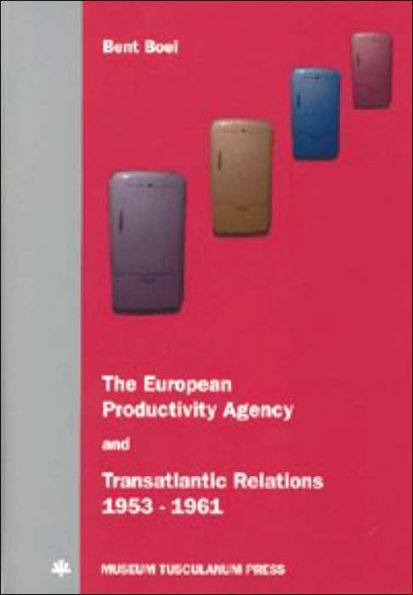5
1


Paperback
$52.00
-
PICK UP IN STORECheck Availability at Nearby Stores
Available within 2 business hours
Related collections and offers
52.0
In Stock
Overview
A study of European co-operation and transatlantic relations in the 1950s as well as on the changes these relations underwent during the early postwar period. The European Productivity Agency (EPA) was created in 1953 as a semi-autonomous organization within the framework of the Organisation for European Economic Co-operation (OEEC) and wound up eight years later, in 1961, when the United States and Canada joined the OEEC countries and founded the Organisation for Economic Co-operation and Development (OECD). It was initially designed as a means to "Americanize" Western Europe through the transfer of American techniques, know-how and ideas to the Old Continent, but, as Boel demonstrates, it increasingly became a framework within which the member countries sought "European" solutions to their problems. The EPA was the product of American ideas, actions and money, and embodied the merger of two of the United States' main foreign policy goals after World War II, namely increasing productivity and furthering integration among the countries of Western Europe. The agency was conceived as a major instrument for the "politics of productivity" which would enable Western European societies to overcome their social and political problems resulting from scarcity, particularly in countries such as France and Italy with strong communist parties. During its short-lived existence the EPA acted as an operational arm of the OEEC, accounting on average for over 40 percent of the overall OEEC expenditures. It implemented a vast array of activities aimed at improving productivity in industry, commerce, agriculture and distribution. Among its endeavours were efforts to develop management education, improve labor-management relations, and assist underdeveloped areas in the member countries. Many of its projects met with contrasted reactions and thus highlighted conflicts between trade unions and employers, differences amongst the OEEC countries as well as transatlantic squabbles. Bent Boel, PhD, is an associate professor in the Department of Languages and Intercultural Studies at the University of Aalborg.

Product Details
| ISBN-13: | 9788772896731 |
|---|---|
| Publisher: | Museum Tusculanum Press |
| Publication date: | 12/04/2003 |
| Series: | Studies in 20th and 21st Century European History |
| Pages: | 294 |
| Product dimensions: | (w) x (h) x 0.90(d) |
About the Author
Bent Boel is associate professor in the Department of Languages and Intercultural Studies at the University of Aalborg.
Table of Contents
AcknowledgementsIntroduction
A. Aims
B. Historiographic Introduction
C. Sources
Chapter I: American Technical Assistance to Western Europe, 1948-53
A. American Initiatives
B. European Policies
C. The Moody Negotiations
D. Europeanizing of the Productivity Drive: Creation of the EPA
E. Conclusion
Chapter II: A Short History of the EPA, 1953-61
A. A Chaotic State (1953-54)
B. The EPA Back on Track (1954-56)
C. The Swiss Crisis (1956-57)
D. In Search of a Role (1958-60)
E. The Winding Up of the EPA (1960-61)
F. Conclusion
Chapter III: An Operational Agency of the OEEC
A. An Operational Body
B. A Branch of the OEEC
C. Working Procedures
D. Administration
E. Conclusion
Chapter IV: An American Aid Agency
A. The US and the Financial Resources of the EPA
B. The US and the EPA’s Program
C. Conclusion
Chapter V: A European Federator
A. The National Productivity Centers
B. Clash of Visions: Leader or Clearing House?
C. The Amended Constitution of the EPA: An Illusory Compromise
D. The Battle Goes On
E. Conclusion
Chapter VI: A Tripartite Organization?
A. America’s Labor Policy in the 1950s and the EPA
B. The Advisory Board
C. “Dividing the Cake” Between Labor and Management
D. Labor and the EPA’s Trade Union Policy
E. The EPA’s Trade Union Activities
F. Impact of the EPA’s Activities
G. Conclusion
Chapter VII: The EPA and Management Education
Chapter VIII: The EPA and Development Aid: The Pilot Area in Sardinia
A. The EPA’s Assistance to Areas in the Process of Economic Development
B. Origins of the Sardinian Pilot Project
C. The Sardinian Pilot Project, 1957-62
D. Activities
E. Handicaps
F. Impact Outside the Pilot Area
G. Conclusion
Chapter IX: Impact of the EPA’s Activities
A. The Projects
B. Assessing the Impact
C. The Countries’ Perceptions
D. Conclusion
Conclusion
List of Abbreviations and Acronyms
Bibliography
Appendices
From the B&N Reads Blog
Page 1 of
